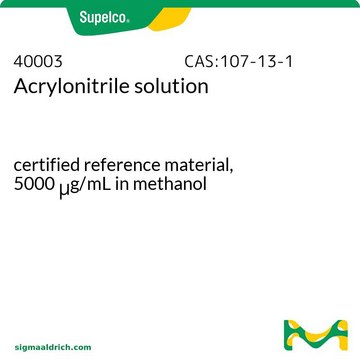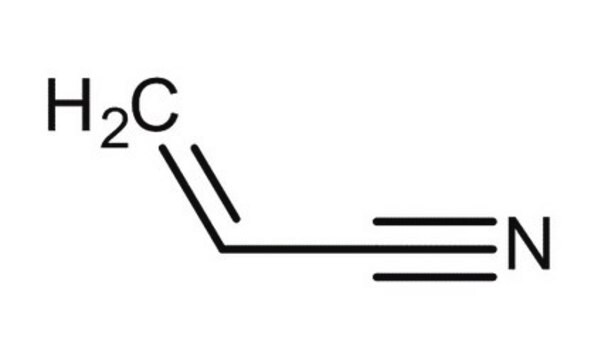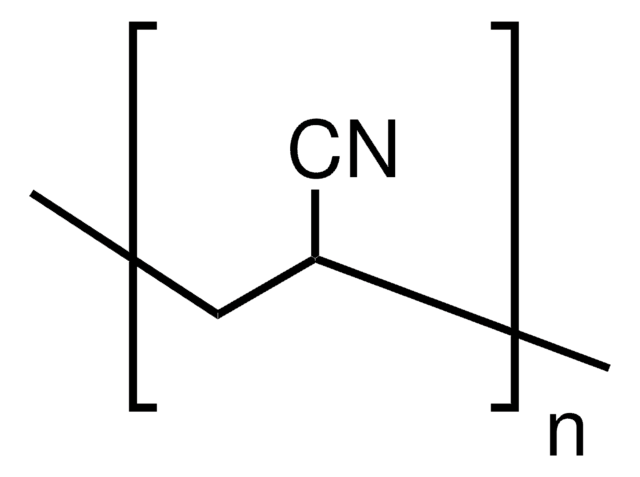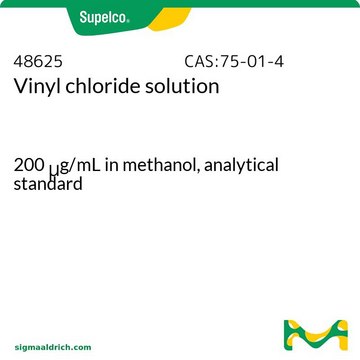Kluczowe dokumenty
31564
Acrylonitrile
analytical standard
Synonim(y):
Vinyl cyanide
About This Item
Polecane produkty
klasa czystości
analytical standard
Poziom jakości
gęstość pary
1.83 (vs air)
ciśnienie pary
86 mmHg ( 20 °C)
Próba
≥98% (GC)
temp. samozapłonu
897 °F
jakość
stabilized
okres trwałości
limited shelf life, expiry date on the label
granice wybuchowości
17 %
metody
HPLC: suitable
gas chromatography (GC): suitable
współczynnik refrakcji
n20/D 1.391 (lit.)
bp
77 °C (lit.)
mp
−83 °C (lit.)
Zastosowanie
cleaning products
cosmetics
environmental
food and beverages
personal care
Format
neat
temp. przechowywania
2-8°C
ciąg SMILES
C=CC#N
InChI
1S/C3H3N/c1-2-3-4/h2H,1H2
Klucz InChI
NLHHRLWOUZZQLW-UHFFFAOYSA-N
Szukasz podobnych produktów? Odwiedź Przewodnik dotyczący porównywania produktów
Opis ogólny
Zastosowanie
Działania biochem./fizjol.
Hasło ostrzegawcze
Danger
Zwroty wskazujące rodzaj zagrożenia
Zwroty wskazujące środki ostrożności
Klasyfikacja zagrożeń
Acute Tox. 3 Dermal - Acute Tox. 3 Inhalation - Acute Tox. 3 Oral - Aquatic Chronic 2 - Carc. 1B - Eye Dam. 1 - Flam. Liq. 2 - Skin Irrit. 2 - Skin Sens. 1B - STOT SE 3
Organy docelowe
Respiratory system
Kod klasy składowania
3 - Flammable liquids
Klasa zagrożenia wodnego (WGK)
WGK 3
Temperatura zapłonu (°F)
23.0 °F - closed cup
Temperatura zapłonu (°C)
-5 °C - closed cup
Środki ochrony indywidualnej
Faceshields, Gloves, Goggles, type ABEK (EN14387) respirator filter
Wykazy regulacyjne
Wykazy regulacyjne dotyczą głównie produktów chemicznych. Można w nich podawać ograniczoną liczbę informacji na temat produktów niechemicznych. Brak wpisu oznacza, że żaden ze składników nie znajduje się w wykazie. Użytkownik odpowiada za zagwarantowanie bezpiecznego i zgodnego z prawem stosowania produktu.
EU REACH Annex XVII (Restriction List)
Wybierz jedną z najnowszych wersji:
Masz już ten produkt?
Dokumenty związane z niedawno zakupionymi produktami zostały zamieszczone w Bibliotece dokumentów.
Klienci oglądali również te produkty
Nasz zespół naukowców ma doświadczenie we wszystkich obszarach badań, w tym w naukach przyrodniczych, materiałoznawstwie, syntezie chemicznej, chromatografii, analityce i wielu innych dziedzinach.
Skontaktuj się z zespołem ds. pomocy technicznej















